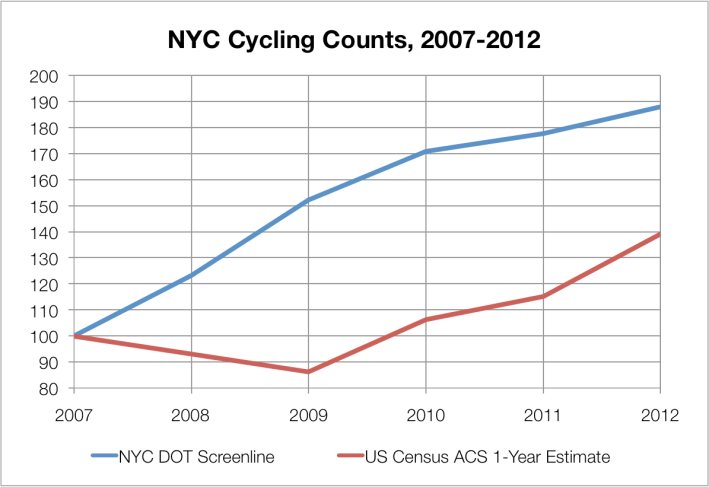
New numbers from the Census Bureau show that cycling to work in New York continued to grow last year, with the city breaking an important symbolic barrier: The percentage of New Yorkers regularly commuting by bike now stands at 1 percent. More than 36,000 city residents regularly commute by bike, up significantly over just a few years before.
Counting the number of people on bikes has long been an imprecise science. While Transportation Alternatives estimated the number of New Yorkers on two wheels each day at 236,000 in 2010, there are a number of assumptions and extrapolations that keep that from being a hard-and-fast-number. Often, it's more instructive to look for trends in imprecise, but consistent, measurements (like the Census numbers) over time.
Each year, the U.S. Census Bureau releases new results from the American Community Survey, which provides estimates on a wide variety of demographic topics, including commuting. On a rolling basis, the ACS asks Americans how they "usually" got to work in the previous week. The question does not accept multiple answers, so someone who commutes by both bike and train, for example, would have to choose only one. The survey does not measure non-work trips.
Last week, the Census released one-year estimates for 2012, which included some notable changes outside the margin of error. The Census estimates that the number of regular bike commuters in the city last year was 36,496, up from 26,243 in 2007.
The percentage of working NYC residents who commute by bike is also up, from 0.6 percent in 2007 to exactly 1 percent today. This number is below other cities, most of which have worse transit service and are geographically much smaller than New York. In Washington, DC, 4.1 percent of working residents regularly commuted by bike last year; it was 3.8 percent in San Francisco, 2.3 percent in Philadelphia, 2 percent in Boston, and 1.6 percent in Chicago.
NYC DOT collects bike ridership data by counting cyclists entering and leaving the Manhattan CBD on the East River bridges, the Staten Island ferry, and the Hudson River Greenway. The city's screenline count has shown uninterrupted, robust growth since 2008, rising 58 percent.
In 2012 the Census measured a bigger increase in cycling than the screenline count. While it's hard to say why, one potential explanation is that bike commuters may be more likely to bike year-round and thus register in the Census survey. This would be consistent with the increasing number of winter cyclists DOT has counted crossing the screenline, which shot up last year while warm-weather cycling stayed flat.





